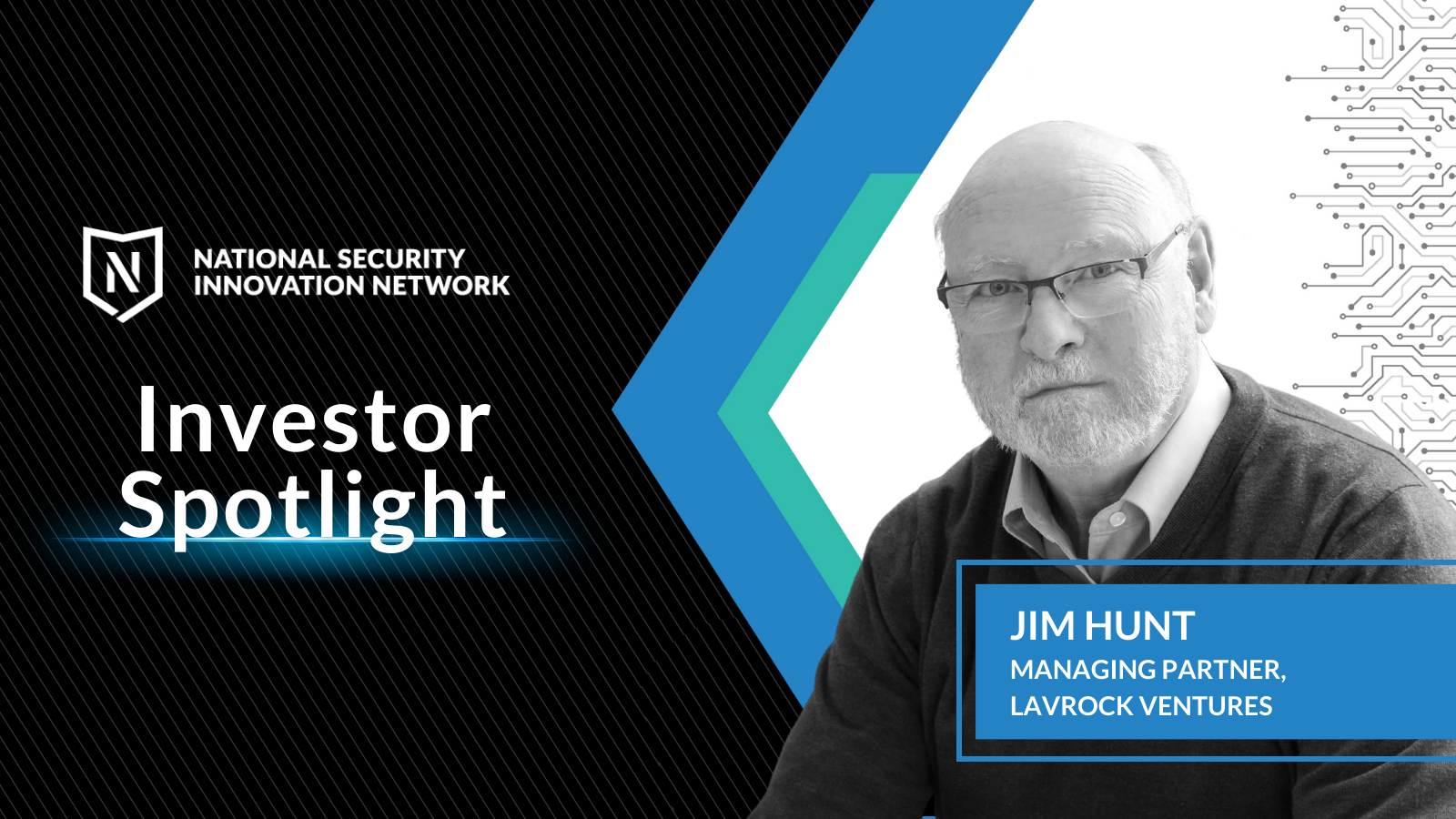
Investor Spotlight - Lavrock Ventures


NAME: Jim Hunt, Managing Partner
COMPANY: Lavrock Ventures
FOUNDED: 2016
HEADQUARTERS: Arlington, VA
TECHNOLOGY VERTICALS FOCUS: Enterprise Software, Data, Deep Tech, Aerospace, and National Security
PREFERRED ROUNDS: Seed, Series A
CHECK SIZE: $2 to $4 Million
NOTABLE INVESTMENTS: Sayari, Apkudo, Cesium, Morpheus Space, Pison, PteroDynamics
Background:
Jim Hunt has built a wide-ranging career starting as a government scientist, then a venture-backed CEO, a public company executive, a three-time founder, an angel investor, and now the managing partner of Lavrock Ventures. Based in the Washington, DC area, Lavrock invests in early-stage companies and entrepreneurs who are working to solve some of the most critical problems facing major institutions in the private and public sectors across North America and Europe.
As an individual, Jim has made over 180 early-stage investments across cyber and physical security, the internet of things, data center management, social media, analytics, and mobile applications. In addition to investing in critical technologies, Jim has been an adjunct professor at Georgetown’s McDonough School of Business for the past 20 years. He is also an adjunct professor at Notre Dame and teaches cornerstone courses in business planning and start-up business management and investing. Jim is a graduate of the University of Notre Dame and Rochester Institute of Technology and sits on the Notre Dame Engineering College Advisory Council.
Q: Lavrock has a stated focus on national security. Why is national security important to Lavrock’s investment strategy?
The intersection of technology, corporate needs, and national security has become an increasingly relevant investment market over time, but it’s also an arena where money simply isn’t enough. Access, knowledge, connections, and often security clearances, are needed. Much of this strategy and interest also relates to my background. My time with the government was in the national security space and I’ve kept a focus on how technology innovation can positively impact the national security mission. Our team at Lavrock is well positioned to continue capitalizing on these advantages for the benefit of our portfolio, our investors, and the overall national security mission.
Q: What do you look for most when considering an investment in a dual-use or national security focused company?
First, from my early experience as an angel investor and through the investment pursuits of Lavrock, we have seen the dual-purpose strategy as both useful to companies and as a strong investment thesis. We try to help the national security mission and we also balance that goal with a focus on standard commercial markets. There is some cyclicality to the two markets which is an added plus as our companies are building out their go-to-market strategies and early revenue plans. Finding a company with the right team that fits a critical mission need, has a crucial business case with a large market opportunity, or ideally has a combination of both elements, is key.
Q: What are the most valuable skills you look for in entrepreneurs? What specific traits or experiences are desirable?
Probably the ability to listen well and have honest dialogue about the constructive input they receive. Also, to be transparent and to not be afraid to inform the board or perhaps others of the challenges facing the company.
From my personal perspective, I not only look for perseverance but also for humility. The founder must be able to drive through the trials at the early stages of starting a company, while at the same time realizing what they don’t know and listening to customers, team members, and perhaps even investors. If there is a sense of arrogance, I personally get concerned that the company will struggle to recruit a quality team and at times will struggle to adapt to what the market and customers tell them. A stubborn founder will frequently fail to tweak their product to match with great product-market fit.
Additionally, I’ve had successful founders from about every functional area, including sales, engineering, admin, and more, but they need to not be afraid to “sell”. Founders are by far the best initial advocates for the products they represent.
Q: Raising capital can be particularly difficult for dual-use startups because their traction is often limited to non-dilutive R&D funding (e.g., SBIRs/STTRs, etc.). How can these companies better position themselves for success when they’re pitching to investors? Is there a certain level of DoD traction or validation that you need to see before investing?
The critical factor for us is, “how well do the SBIR and/or other government research dollars parallel and fund the commercial product development roadmap?” In a market like we have now, the federal research dollars are very helpful, and as long as that work does not detract from the commercial product roadmap, we find those dollars very beneficial. But at the end of the day, the commercial revenue is what will be valued highest at any exit or follow-on round.
Q: What is your framework for valuing early-stage dual-use companies that have successfully received non-dilutive R&D awards from the DoD but they have limited commercial traction?
Being seduced by federal grant funding can be a very bad thing – for both the government and for a company’s commercial objectives. A lack of commercial traction for a dual-use company clearly hurts that company’s valuation. If there is little or no commercial traction, we really have to extend our diligence on the company to understand if they can be effective at driving their product into commercial markets in the future. If we can’t see that as likely to happen, it becomes difficult for us to get a consensus on the decision to invest.
Q: Investors often encourage founders to focus on commercial traction first and then come back to the defense market once they’ve reached a level of maturity. What is your perspective?
Not only do investors encourage a company to first find success in the commercial markets, so do many government funders. Many people correctly perceive that any company which cannot be commercially successful may struggle to become financially viable in the end. That fragility can make any relationship with the government buyers perilous if the company struggles to survive. On the other hand, if commercial markets are tight, early-stage companies can find non-dilutive funding opportunities that maintain their product development. The dual-market focus can be very complementary.
Q: What other investors do you work with most often to fund later-stage companies? There seems to be a lack of growth capital funds that target government technology.
That may have been an accurate statement as recently as a year ago, but I’m not sure that’s the case today. There are enlightened VCs with larger funds who are showing much more interest in the dual-use space, particularly with the successes of companies like Anduril, Palantir, Scale, Shield, etc. There are several examples of other firms, but one that comes to mind is the formation and success of the recently created U.S. Innovation Technology Fund.
Q: What technology areas that overlap with national security do you think have the most opportunity for growth in the next 5-7 years?
The requirements for back-end operations at the national security agencies and departments are very similar to the requirements of corporate America. Requirements include areas such as enterprise resource planning (ERP), customer relationship management (CRM), human resources (HR), etc. As we move more toward more front-end mission requirements, there are many parallel national security and corporate needs in cyber, analytics, advanced sensors, and a host of other hardware and software solutions.
Q: What was the biggest mistake you made while running your own startup and what did you learn from it?
Spending money in anticipation of revenue. I learned that cash is king, and founders frequently are overly optimistic in developing their forecasts…